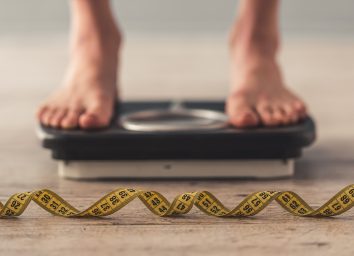Walking at This Time Can Help You Lose More Weight

Getting your steps in each day provides many benefits, mentally and physically. While any movement throughout the day, walking or otherwise, can be helpful for weight loss, there is research that suggests walking after a meal may provide additional benefits. Let's take a look at how exercise can influence weight loss, how much you need to walk each day, how to maximize the benefits of exercise, and why this is ultimately the best time to walk to lose weight. And for more healthy tips, be sure to check out our list of 21 Best Healthy Cooking Hacks of All Time.
How walking can lead to weight loss
We each have a base amount of calories we burn in a day. This is often referred to as your resting metabolism, and while that number stays relatively stable, the amount of movement we do each day through walking around the house, running errands, and intentional exercise can significantly increase your total calorie burn.
Weight loss is not always a straightforward calorie equation, but energy in versus energy out plays a major role in weight loss. Adding more movement each day is likely to be helpful in that calorie equation and aid in a weight loss goal.
Additionally, exercise can help manage blood sugar levels, another benefit aiding in weight loss. A 2016 study found walking for 10 minutes after each meal helps to lower blood sugar levels in those with Type 2 diabetes more than walking for 30 consecutive minutes at any other time throughout the day. While this study focused on those with diabetes, it is reasonable to expect similar outcomes in those with prediabetes, according to this study from 2013.
Walking helps your blood sugar levels.
What is the mechanism behind exercise helping manage blood sugar levels? It is pretty simple. As your heart rate increases during moderate-intensity exercise, your muscles start to prefer carbohydrate, or sugar, as a primary energy source. When you eat carbohydrates at a meal, your blood sugar naturally starts to rise and it is the job of insulin to help pull that sugar out of the blood and deliver it to the different tissues of the body. Walking increases the amount of sugar your muscles require and helps to make use of the excess sugar that may be in your bloodstream following a meal.
Managing blood sugar levels is extremely important for cardiovascular health and may also make weight loss easier. Post-meal exercise serves two major benefits for weight management: It increases calorie burn to encourage your body to use fat as an energy source, and it helps manage blood sugar levels that support overall health and alleviate the pancreas of additional work trying to manage blood sugar with insulin.
While there are many recommendations that exist for the amount and type of exercise you should be getting, the American Heart Association recommends 150 minutes of moderate-intensity aerobic exercise, like walking, each week. Walking just 21 minutes per day at a moderate speed may reduce the risk for heart disease and Type 2 diabetes, which is especially important for the 34.5% all US adults who have prediabetes and can support better bone health and promote less weight gain.
Why you should walk after a meal.
Walking at any time during the day can be beneficial for physical and mental well-being, however, walking after meals may be particularly helpful for those with pre-diabetes and Type 2 diabetes as the increased movement is able to remove some of the excess sugar in the blood and put it to work in muscle tissue. For those without any health conditions who are aiming to lose weight or use exercise to prevent future health complications, walking can be a valuable component in your daily routine.
To get started today, here are 30 Tips When You're Walking for Weight Loss.








